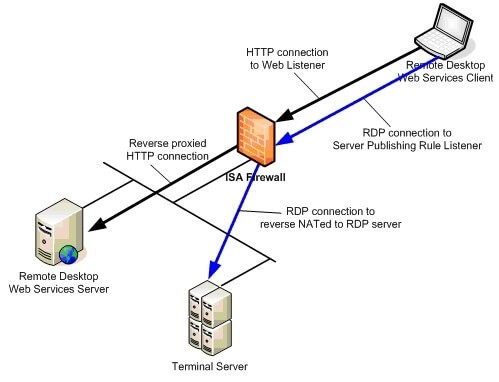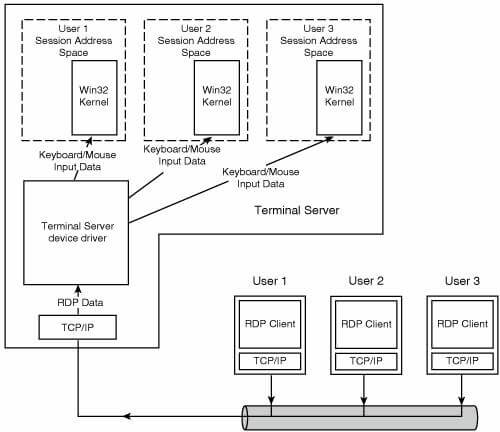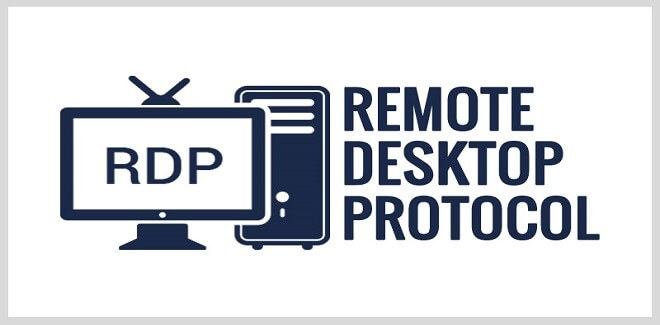RDP Download | Remote Desktop Protocol Download (RDP) is a secure network communications protocol that provides remote display and input capabilities over network connections for Windows-based applications running on a server. RDP is a proprietary protocol developed by Microsoft, and it provides a user with a graphical interface such that to connect to another computer over a network connection. The user employs RDP client software for this purpose, while the other computer must run on the RDP server software. RDP is designed to support multiple LAN protocols and different types of network topologies. Remote Desktop Protocol is a multiple-channel capable protocol that allows for separate virtual channels for carrying device communication and presentation data from the server, as well as encrypted client mouse and keyboard data.

Remote Desktop Protocol Architecture
RDP is based on an addition of the ITU T.120 family of protocols. The Remote Desktop Protocol is an extension of the ITU-T T.128 application sharing protocol. Being a multiple-channel capable protocol, RDP allows separate virtual channels to carry device communication and presentation data from the server, along with the encrypted client mouse and keyboard data. RDP provides an extensible base and supports up to 64,000 separate channels for the transmission of data and provisions for multipoint transmission.
On the server, RDP Viewer uses its video driver to provide display output by constructing the rendering information into network packets by using the Remote Desktop Protocol client and sending them to the client over the network. It is the same technique as that of the Radmin (Remote Administrator) to control another computer remotely. On the client, RDP receives furnishing data and interprets the packets into corresponding Microsoft Windows graphics device interface (GDI) API calls. For the input path, client mouse and keyboard events are redirected from the client to the server. On the server, RDP uses its keyboard and mouse driver to receive these keyboard and mouse events.

In a Remote Desktop session, all the environment variables, such as variables determining the colour depth and wallpaper enabling and disabling, are also determined by the RCP-TCP connection settings. It is applied to all the functions and methods that set environment variables in the Remote Desktop Services WMI Provider Interface and Remote Desktop Web Connection Reference. Use the Angry IP Scanner to search the network users and port scans.
Download Remote Desktop Protocol For Windows:
Click the link to Download RDP – Remote Desktop Protocol.
Download Remote Desktop Protocol For Mac:
Click the link to Download RDP – Remote Desktop Protocol.
Features of Remote Desktop Protocol
Encryption – RDP uses RSA Security’s RC4 cipher, a stream cipher designed to encrypt small amounts of data efficiently. RC4 is designed for secure communications over networks. Administrators could choose to encrypt data by using a 56- or 128-bit key.
Bandwidth Eduction Features – RDP supports various mechanisms to reduce the amount of data transmitted over a network connection. Mechanisms include data compression, persistent caching of bitmaps, and caching of glyphs and fragments in RAM.
Roaming Disconnect – A user can manually disconnect from a remote desktop session without logging off. The user is automatically reconnected to their disconnected session when the user logs back onto the system, either from the same device or a different device. When a user’s session is unexpectedly terminated by a network or client failure, the user is disconnected from the RDP Network but not logged off.
Clipboard Mapping – Users can delete, copy, and paste text and graphics between applications running on the local computer and those running in a remote desktop session and between sessions.

Print Redirection – Applications running within a remote desktop session can print to a printer attached to the client device.
Virtual Channels – By using RDP virtual channel architecture, existing applications can be augmented, and new applications can be developed to add features that require communications between the client device and an application running in a remote desktop session.
Remote Control – Computer support staff can view and control a remote desktop session. Sharing input and display graphics between two remote desktop sessions gives a support person the ability to diagnose and resolve problems remotely. Use Advanced IP Scanner to scan for the IP addresses in any range as well as in any ports.
Network Load Balancing – RDP takes advantage of network load balancing (NLB), where available.
Also, RDP contains the following features:
- RDP has the support for 32-bit colour. It also supports 8-, 15-, 16-, and 24-bit color.
- RDP supports 128-bit encryption by using the RC4 encryption algorithm as of Version 6.
- Improved performance over low-speed dial-up connections takes place in RDP through reduced bandwidth.
- RDP has Smart Card authentication through the Remote Desktop Services.
- RDP supports Keyboard hooking, which is the ability to direct special Windows key combinations, in the full-screen mode, to a local computer or a remote computer.
- Audio Redirection enables the users to process audio on a remote desktop and have the sound redirected to their local computer. The sounds that occur on the remote computer could be heard on the client computer running the RDC client, and the local client drives would be visible to the remote desktop session.
- File System Redirection enables the users to use their local files on a remote desktop within the terminal session.
- Printer Redirection enables the users to use their local printer within the terminal session since they would work with a locally or network-shared printer.
- Port Redirection enables the applications running within the terminal session to access the local serial and parallel ports directly.
- The remote computer and the local computer could share the clipboard.
Working of Remote Desktop Protocol
The RDP protocol is designed to provide remote access through port 3389. An RDP-enabled application or the service packages data that are to be transmitted, and the Microsoft Communications Service directs the data to an RDP channel. From there, the operating system will encrypt the RDP data and adds it to a frame so that it could be transmitted. The Terminal Server Device Redirector Driver handles all the RDP protocol activity. The driver is made up of subcomponents such as the RDP driver (Wdtshare.sys), which handles the user interfaces, transfers, encryption, compression, and framing. The transport driver (Tdtcp.sys) is responsible for packaging the protocol in such a way that allows it to be sent across the TCP/IP network. The Advanced Network Scanner performs ping sweep, and scans for opened TCP and UDP ports, resource shares, and services.
The setup of RDP software is easy to do. Users only need to open the main dialog box and enter the network ID of the computer to which they wanted to connect to, and the connection gets established almost instantly. The user could alternatively enter the name of the computer with which the connection needs to be made. The user must be sure that the Terminal Services is activated on both the machines, or the connection prompt would be rejected. It is also possible to choose or configure personal preferences. It may include making the hard drives accessible to both the computers along with selecting the resolution of the machines.
RDP Software Supported Services:
- Mouse and the user keyboard data encryption
- Audio, printer, port, and file redirection
- Clipboard sharing among a remote server and a local client
- Remote desktop applications run on the client machines using a remote desktop connection
- Remote Desktop Services (RDS) that provides RDP functionality via Windows 2008 R2 with the Service Pack 1 (SP1)
Multiple features were added to the RDP version 6.0. These include Aero Glass remoting, multiple monitor support, Windows Media Player (WMP) redirection, Windows Presentation Foundation (WPF) applications, and remoting. RDP can also be implemented on non-Microsoft platforms. For example, “rdesktop” is a command-line client used on Unix and Linux platforms. Advanced Port Scanner has a large number of descriptions for the most common ports, and it lets you scan on a predefined port range.
Other Softwares Related to RDP
We hope our post is very useful. If you have any queries regarding Remote Desktop Protocol, please comment below.

